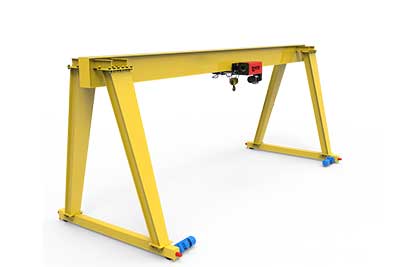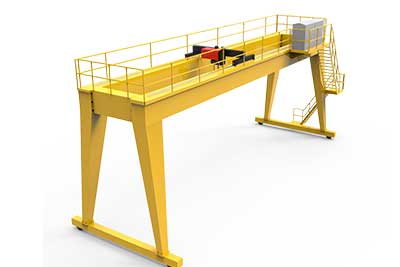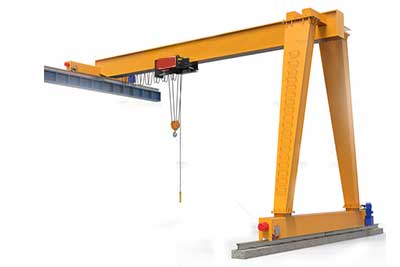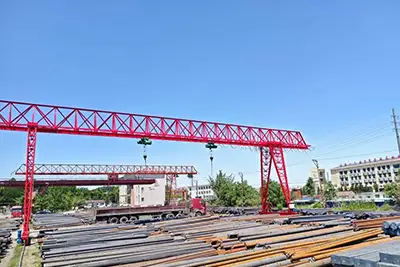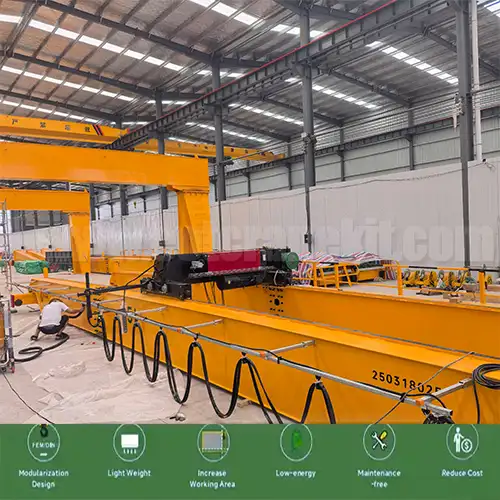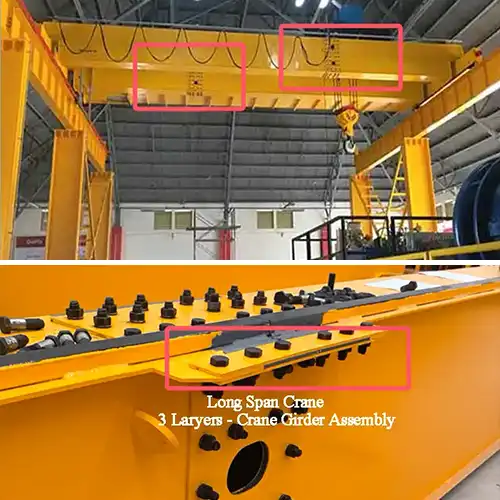15 Ton Gantry Crane for Steel Mill Applications
Check how 15-ton gantry cranes improve steel mill operations, safely handling billets, slabs, coils, and structural steel with efficiency and reliability.
Category: 15 Ton Gantry Crane
Your Trusted Overhead Crane Manufacturer & Supplier
15 Ton Gantry Crane for Sale, Tailored Industrial Gantry Crane for Steel Mills
15 Ton Gantry Crane for Steel Mill Applications
Gantry cranes are essential equipment in steel mills, handling heavy and bulky materials that would otherwise be difficult or unsafe to move. Unlike overhead cranes fixed to building structures, gantry cranes can operate in open spaces, making them ideal for outdoor yards, loading docks, or areas with limited infrastructure.
A 15 ton gantry crane is particularly popular in steel mill applications. It provides enough lifting power to handle common steel products while maintaining flexibility for tighter spaces or changing workflows. In short, it hits the sweet spot between strength and versatility.
The goal of this guide is simple: to help steel mill operators and crane buyers understand how a 15-ton gantry crane can be applied effectively. From choosing the right accessories to understanding material-specific handling challenges, this article focuses on practical insights that can be directly applied in everyday operations.
What You Will Learn in This Guide:
- How a 15-ton gantry crane supports typical steel mill operations.
- Practical approaches to handling billets, slabs, coils, and structural components.
- Important operational factors such as safety, maintenance, and efficiency.
- Tips for selecting the right crane for current needs and potential future growth.
Key Features of a 15 Ton Gantry Crane for Steel Mills
A 15-ton gantry crane is designed for safe, efficient handling of steel billets, slabs, coils, and structural components, even in harsh mill environments.
Load Capacity and Safety Factors
In steel mills, loads are often uneven, hot, or bulky. A 15-ton gantry crane provides enough capacity for most handling tasks while maintaining safety margins. Proper load planning prevents accidents and mechanical wear.
- Rated lifting capacity: 15 tons.
- Built-in overload protection for safe operation.
- Matching lifting accessories to load type and weight.
Span, Lifting Height, and Duty Cycle
The crane's span and lifting height must align with steel yard layouts, storage stacks, and production lines. The duty cycle classification ensures the crane can handle frequent lifts without premature wear, which is crucial in a 24/7 mill environment.
- Span options customized for workshop or yard width.
- Lifting height adjustable for various material stacks.
- Duty cycle rating ensures reliable continuous operation.
Structural Design: Single vs. Double Girder
Steel mill operations require stability and strength. Single girder cranes work well for moderate loads, while double girder designs handle longer or heavier billets, slabs, and structural steel with minimal deflection.
- Single girder: lighter, cost-effective, suitable for moderate steel loads.
- Double girder: strong, stable, ideal for heavy or long materials.
Mobility Options
Depending on layout and workflow, steel mills may need cranes that move between areas or remain fixed. Mobility influences efficiency in handling steel products across different production zones.
- Fixed: permanent rails for repetitive handling areas.
- Semi-portable: occasional repositioning for flexible operations.
- Fully mobile: wheels and rails for coverage of multiple sections.
Compliance with Industrial Standards
Safety and reliability are critical in steel mills. Certified cranes meet CE, ISO, and local regulations, ensuring that lifting mechanisms, electrical systems, and structural components are safe under heavy-duty mill conditions.
- CE/ISO certified for industrial quality assurance.
- Conforms to local safety and operational regulations.
- Regular inspections maintain compliance and performance.

rail mounted gantry crane for steel coil handling in outdoor yard
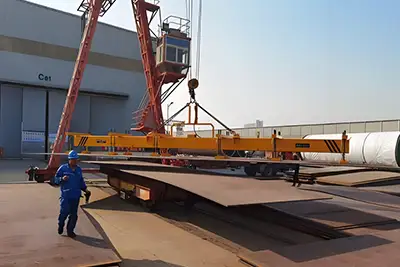
15 ton gantry crane with magnetic spreader for steel plate handling

15 ton gantry crane for indoor steel rebar handling
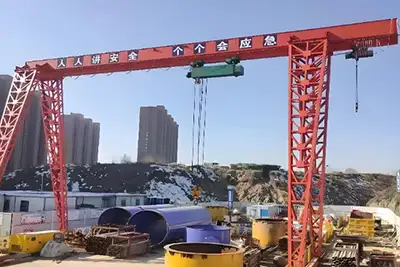
steel pipe handling gantry crane with double hoist trolleys
Industry-Specific Applications in Steel Mills
A 15-ton gantry crane is versatile for steel mill operations, handling billets, slabs, coils, and structural components safely and efficiently.
Handling Billets
Gantry cranes for billets handling . Billets are semi-finished steel bars that are hot and heavy, often stacked in bundles. Handling them requires both precision and care to prevent accidents and material damage.
- Dimensions and weight: Length 4–6 m, cross-section 100–150 mm, weight 0.5–2 tons per billet; bundles up to 10–15 tons.
- Lifting accessories: Magnetic lifters, C-hooks, or mechanical clamps for bundles.
- Safety tips: Plan lifting paths to avoid collisions, maintain safe distances from hot billets, and ensure the crane's rated load exceeds bundle weight with a safety margin.
Handling Slabs
Slabs are large flat steel pieces, heavier and bulkier than billets. Slab handling cranes often have hot or scaled surfaces, making gripping and lifting challenging.
- Sizes and weights: Length 4–8 m, width 1.5–2.5 m, thickness 0.15–0.3 m, weight 8–25 tons per slab.
- Handling challenges: Hot or cold surfaces, scale, or oil can reduce friction and affect grip.
- Crane adaptations: Use spreader beams, slab clamps with adjustable jaws, and proper slings to prevent bending or twisting.
Handling Coils
Steel coils are sensitive to deformation and require careful lifting to maintain quality. Proper coi handling cranes ensures safety and prevents damage to finished steel products.
- Dimensions and weight: Diameter 1–2 m, width 0.5–2 m, weight 5–15 tons per coil. Core integrity is critical.
- Lifting accessories: Coil hooks, C-hooks, or specialized tongs depending on coil size and orientation.
- Precautions: Avoid sudden swings, ensure even weight distribution, and use protective padding when handling finished surfaces.
Handling Structural Components
Structural steel components, like beams, plates, and fabricated sections, require stability and careful planning, especially if the load is long or uneven.
- Types of components: I-beams, H-beams, channels, steel plates, and assemblies.
- Strategies for lifting: Position lifting points near the center of gravity, use multiple synchronized hooks for long loads.
- Accessories: Lifting beams, adjustable clamps, and custom fixtures for complex shapes or assemblies.
Operational Considerations for Steel Mill Gantry Cranes
Operating a 15-ton gantry crane in a steel mill comes with unique challenges. Hot materials, dust, heavy workloads, and continuous operation require careful planning to maintain safety, efficiency, and long-term performance.
Safety Measures
Safety is critical when handling heavy steel products like billets, slabs, and coils. Proper procedures and equipment reduce the risk of accidents and equipment damage.
- Load testing: Regular tests ensure the crane can handle rated capacity plus safety margins.
- Anti-sway systems: Reduce swinging of hot or heavy loads for more precise placement.
- Operator training: Skilled operators understand load behavior, emergency procedures, and material-specific handling techniques.
Maintenance Needs
Steel mill environments are harsh, with high temperatures, dust, and occasional sparks or scale. Maintenance routines must address these conditions to prevent breakdowns.
- Regular lubrication of moving parts to prevent wear.
- Cleaning electrical components and wire ropes to avoid dust accumulation.
- Scheduled inspections for structural integrity and hoist mechanism performance.
Power Supply and Control Systems
Reliable and compatible power systems are vital for smooth crane operation. Control systems must allow precise movements for heavy, sometimes awkward, steel loads.
- Stable voltage supply matching crane specifications.
- Choice between pendant control, radio remote, or cabin operation depending on site layout.
- Emergency stop systems and limit switches for added safety.
Integration with Steel Mill Workflows
A crane should complement existing production lines rather than disrupt them. Planning installation, travel paths, and lifting schedules improves efficiency and reduces downtime.
- Align crane routes with material flow from rolling mills, storage yards, and fabrication areas.
- Coordinate lifts to avoid bottlenecks during peak production hours.
- Ensure compatibility with forklifts, conveyors, and other handling equipment.
Practical Tips for Steel Mill Crane Buyers
Choosing the right 15-ton gantry crane for a steel mill goes beyond price. It requires understanding your operation, material types, and long-term production plans. Making informed decisions can save time, reduce maintenance costs, and improve workflow efficiency.
Assess Materials and Load Requirements
Steel mills handle a wide variety of products, from billets and slabs to coils and structural components. Knowing the exact weights, sizes, and handling frequency helps in selecting a crane that matches your daily operational needs.
- Identify typical load weights and maximum bundles or slabs.
- Consider irregular or uneven loads that may require specialized lifting accessories.
- Plan for high-temperature or dusty material conditions that affect crane performance.
Consider Future Expansion
Production demands can increase, or new materials may be introduced. Selecting a crane with some extra capacity ensures it remains useful as your operation grows.
- Evaluate whether occasional heavier loads may be added in the future.
- Factor in potential yard expansions or changes in storage layout.
- Choose adaptable lifting accessories for future material types.
Evaluate Local Service and Spare Parts
Fast access to service and spare parts reduces downtime in steel mill operations. Reliability is not only about the crane itself but also about support availability.
- Check if local technicians are trained for your crane model.
- Confirm availability of critical components like hoists, motors, and controls.
- Ensure the manufacturer provides clear maintenance schedules and support options.
Choose Proven Performance in Steel Mill Conditions
Not all cranes are built for harsh steel mill environments. Selecting a crane with proven performance in similar conditions reduces operational risks.
- Look for cranes successfully operating in other steel mills.
- Verify compliance with industrial standards like CE, ISO, and local safety regulations.
- Consider user reviews or case studies from similar applications.
Case Studies / Examples of 15-Ton Gantry Cranes in Steel Mills
Example 1: Billet Handling
In a medium-sized steel mill, a 15-ton gantry crane was used to move hot billets from the casting area to the cooling yard. The crane handled bundles weighing up to 12 tons each.
- Magnetic lifters and C-hooks allowed quick gripping and placement.
- Operators followed strict load paths to avoid collisions with stacked billets.
- Anti-sway controls minimized swinging during transfer, improving safety and precision.
Example 2: Coil Loading/Unloading in a Hot Rolling Mill
A hot rolling mill used a 15-ton gantry crane to load and unload steel coils from processing lines. Coils weighed between 8 and 14 tons and required careful handling to prevent deformation.
- Specialized coil hooks and tongs preserved coil integrity.
- Operators maintained consistent lifting speed and controlled swinging.
- The crane's adjustable lifting height allowed placement onto storage racks without disrupting workflow.
Example 3: Structural Steel Component Assembly
In a fabrication yard, a 15-ton gantry crane assisted in assembling structural steel components, including I-beams and plates. Components were often long and uneven, requiring precise handling.
- Lifting beams and adjustable clamps distributed weight evenly.
- Multiple synchronized lifts were used for longer or irregular pieces.
- The crane's mobility allowed movement between assembly stations, improving overall efficiency.
Conclusion
Choosing the right 15-ton gantry crane is more than just picking a piece of equipment—it's about ensuring your steel mill runs safely and efficiently. The right crane makes handling billets, slabs, coils, and structural components faster, smoother, and more reliable.
Safety, operational efficiency, and long-term reliability should always guide your decision. A crane that meets these standards reduces downtime, minimizes maintenance, and protects both workers and materials from accidents or damage.
Finally, working with experienced crane manufacturers is key. They can provide tailored solutions, recommend the right lifting accessories, and ensure compliance with industrial standards. Partnering with a knowledgeable supplier helps guarantee that your gantry crane will perform consistently now and adapt to future production needs.
Related Products
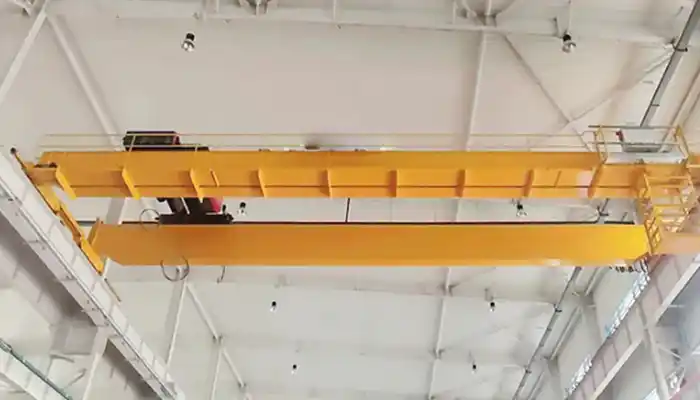
Latest project
Workshop Overhead Crane 5 Ton & 10 Ton Buying Guide
Practical guide for selecting, installing, and maintaining 5 ton to10 ton workshop overhead cranes for safe, efficient, and reliable material handling.
Free consultation to Confirm Parameters & Specifications and Get
Latest Crane Price & Crane Rate.
- Types of overhead cranes : _______?
- Optional: Overhead travelling crane, goliath gantry crane,Slewing jib crane, Single girder or double girder crane,small portable crane or kbk crane, etc.
- Capacity of overhead crane: _______?
- Optional: 0.25ton, 0.5 ton, 1 ton, 2 ton, 3ton, 5 ton, 10 ton,15ton, 20ton, 25 ton, 30ton,35ton, up to 550ton, etc.
- Crane span & lifting height : _______?
- Crane travelling length : _____?
- Control of overhead crane:_______?
- Optional: pendant/ remote/cabin control
- Voltage supply of overhead crane:_____?
- Eg,: 380V50/60HZ,3Phase or others,etc.
- Application/usage of crane:_______?
- Eg,: Steel mill, ,injection mold, cement,stone, concrete,granite, general manufacturing, etc.
Just leave a message via the contact form and our hoist and crane engineer will contact you with in 24working hours.
Get In Touch

